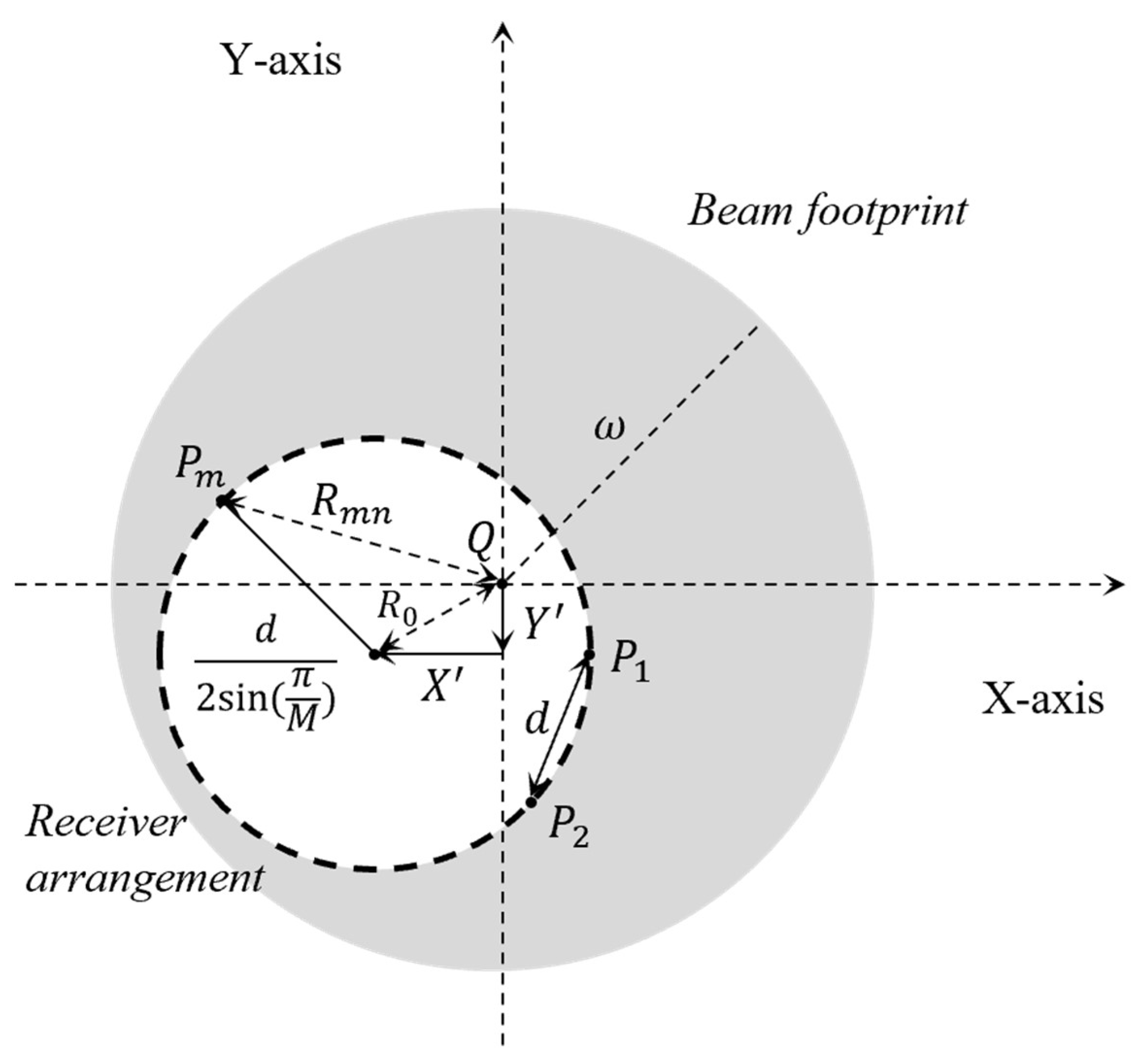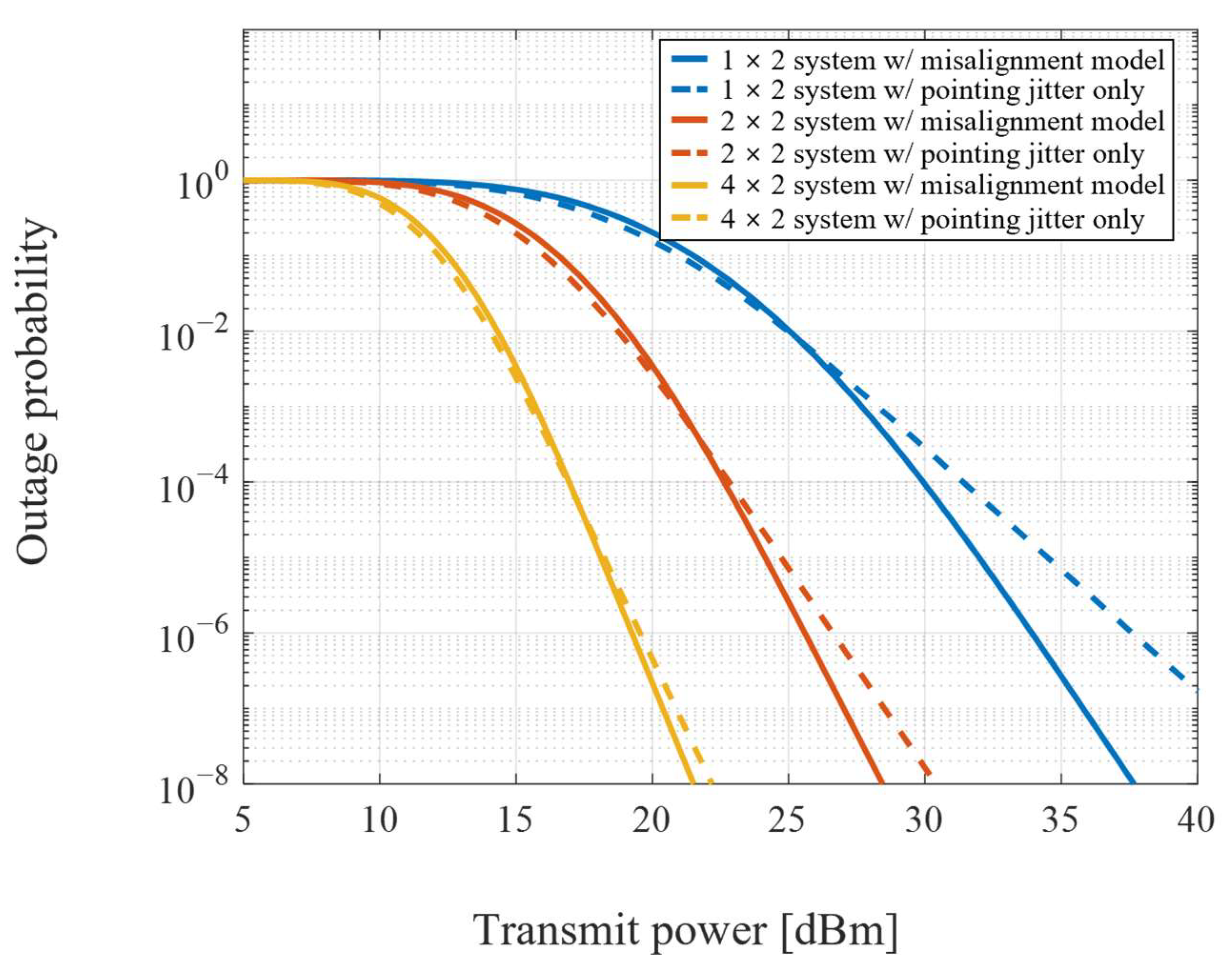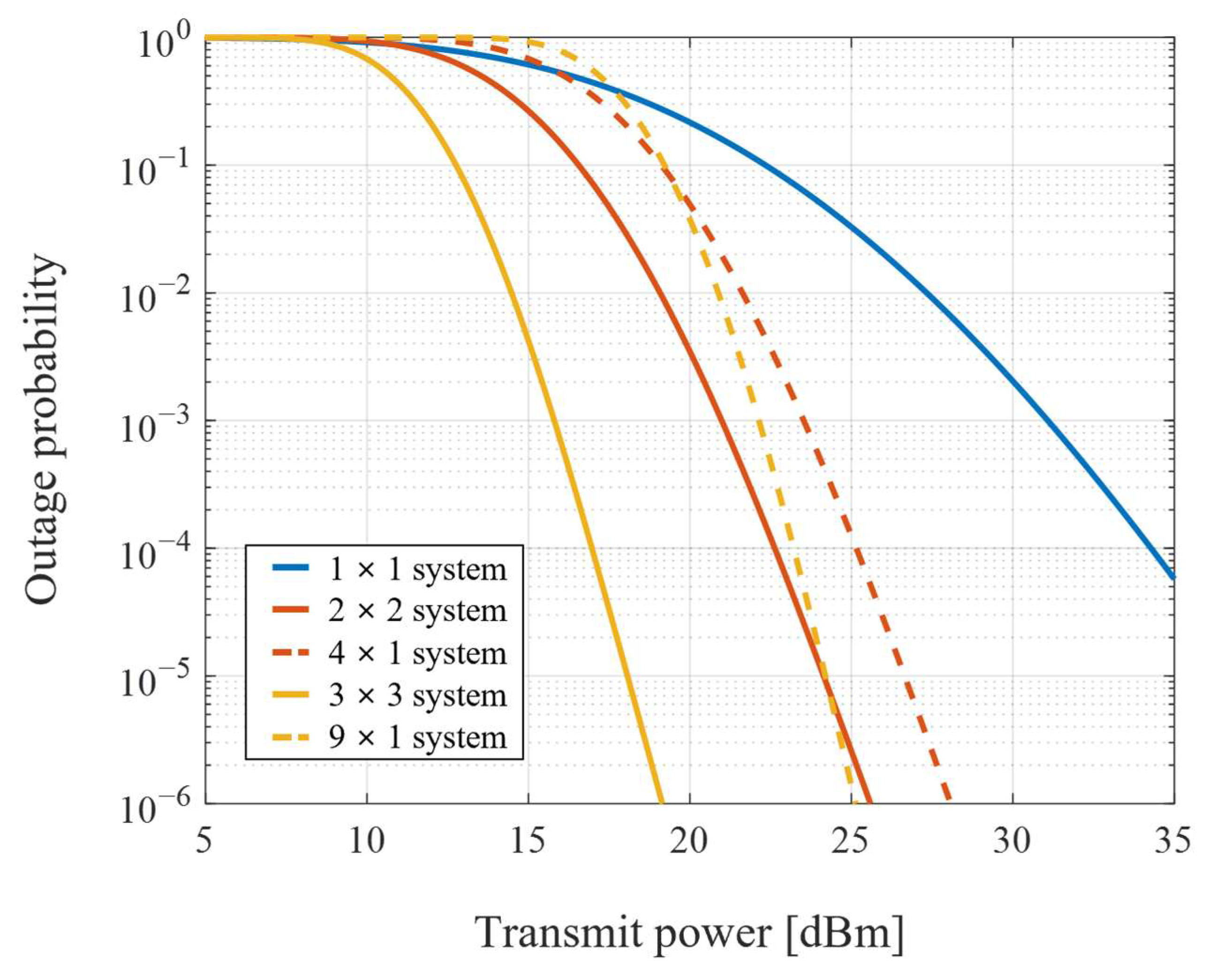Efficient MIMO Configuration for Bi-Directional Vertical FSO Link with Multiple Beam Induced Pointing Error
Abstract
1. Introduction
2. FSO Channel Model
2.1. Atmospheric Turbulence Channel
2.2. Pointing Error Model
3. Diversity Performance
4. Performance Analysis
4.1. Simulation Results for the Misalignment Model
4.2. Transmission Performance
5. Conclusions
Author Contributions
Funding
Institutional Review Board Statement
Informed Consent Statement
Data Availability Statement
Conflicts of Interest
Appendix A
References
- Khalighi, M.A.; Uysal, M. Survey on free space optical communication: A communication theory perspective. IEEE Commun. Surv. Tutor. 2014, 16, 2231–2258. [Google Scholar] [CrossRef]
- Alzenad, M.; Shakir, M.Z.; Yanikomeroglu, H.; Alouini, M.S. FSO-based vertical back-haul/fronthaul framework for 5G+ wireless networks. IEEE Commun. Mag. 2018, 56, 218–224. [Google Scholar] [CrossRef]
- Jahid, A.; Alsharif, M.H.; Hall, T.J. A contemporary survey on free space optical communication: Potentials, technical challenges, recent advances and research direction. J. Netw. Comput. Appl. 2022, 200, 103311. [Google Scholar] [CrossRef]
- Kaushal, H.; Kaddoum, G. Optical communication in space: Challenges and mitigation techniques. IEEE Commun. Surv. Tutor. 2017, 19, 57–96. [Google Scholar] [CrossRef]
- Kaymak, Y.; Rojas-Cessa, R.; Feng, J.; Ansari, N.; Zhou, M.C. A survey on acquisition, tracking, and pointing mechanisms for mobile free-space optical communications. IEEE Commun. Surv. Tutor. 2018, 20, 1104–1123. [Google Scholar] [CrossRef]
- Czaputa, M.; Javornik, T.; Leitgeb, E.; Kandus, G.; Ghassemlooy, Z. Investigation of punctured LDPC codes and time-diversity on free-space optical links. In Proceedings of the 11th International Conference on Telecommunications (ConTEL), Graz, Austria, 15–17 June 2011; pp. 359–362. [Google Scholar]
- Weerackody, V.; Hammons, A.R. Wavelength correlation in free space optical communication. In Proceedings of the IEEE Military Communications Conference (MILCOM), Washington, DC, USA, 23–25 October 2006; pp. 1–6. [Google Scholar]
- Chen, Z.; Yu, S.; Wang, T.; Wu, G.; Wang, S.; Gu, W. Channel correlation in aperture receiver diversity systems for free-space optical communication. J. Opt. 2012, 14, 125710. [Google Scholar] [CrossRef]
- Das, A.; Bag, B.; Bose, C.; Chandra, A. Free space optical links over Málaga turbulence channels with transmit and receive diversity. Opt. Commun. 2020, 456, 124591. [Google Scholar] [CrossRef]
- Farid, A.A.; Hranilovic, S. Outage capacity for MISO intensity-modulated free-space optical links with misalignment. J. Opt. Commun. Netw. 2011, 3, 780–789. [Google Scholar] [CrossRef]
- Farid, A.A.; Hranilovic, S. Diversity gain and outage probability for MIMO free-space optical links with misalignment. IEEE Trans. Commun. 2012, 60, 479–487. [Google Scholar] [CrossRef]
- Ding, J.; Yu, S.; Fu, Y.; Ma, J.; Tan, L. New approximate and asymptotic closed-form expressions for the outage probability and the average BER of MIMO-FSO system with MRC diversity technique over Gamma-Gamma fading channels with generalized pointing errors. Opt. Commun. 2020, 456, 124633. [Google Scholar] [CrossRef]
- Miao, M.; Li, X. Novel approximate distribution of the sum of Gamma–Gamma variates with pointing errors and applications in MIMO FSO links. Opt. Commun. 2021, 486, 126780. [Google Scholar] [CrossRef]
- Ruiz, R.B.; Zambrana, A.G.; Vazquez, B.C.; Vazquez, C.C. Impact of nonzero boresight pointing error on ergodic capacity of MIMO FSO communication systems. Opt. Express 2016, 24, 3513–3534. [Google Scholar] [CrossRef] [PubMed]
- Fu, Y.; Ma, J.; Yu, S.; Tan, L. BER performance analysis of coherent SIMO FSO systems over correlated non-Kolmogorov turbulence fading with nonzero boresight pointing errors. Opt. Commun. 2019, 430, 31–38. [Google Scholar] [CrossRef]
- Zheng, A.; Huang, Y.; Gao, S. Modeling and Spatial Diversity-Based Receiving Improvement of In-Flight UAV FSO Communication Links. Appl. Sci. 2021, 11, 6362. [Google Scholar] [CrossRef]
- Khallaf, H.S.; Mohamed, E.M.; Yanikomeroglu, H. Composite fading model for aerial MIMO FSO links in the presence of atmospheric turbulence and pointing errors. IEEE Wirel. Commun. Lett. 2021, 10, 1295–1299. [Google Scholar] [CrossRef]
- Kim, S.J.; Han, S.K. Estimation and performance analysis of multiple incident beam misalignment in spatial diversity based FSO transmissions. Opt. Commun. 2022, 521, 128618. [Google Scholar] [CrossRef]
- Andrews, L.C.; Phillips, R.L. Laser Beam Propagation through Random Media; SPIE: Bellingham, WA, USA, 2005. [Google Scholar]
- Beaulieu, N.C.; Abu-Dayya, A.A.; McLane, P.J. Estimating the distribution of a sum of independent lognormal random variables. IEEE Trans. Commun. 1995, 43, 2869–2873. [Google Scholar] [CrossRef]
- Horwath, J.; Ganzalez, D.D.; Navajas, L.M.; Souto, A.L.; Semerjyan, V.; Raju, G.; Grabowsky, J.; Garcia, C.; Lai, Y.; Bähr, T.; et al. Test results of error-free bidirectional 10 gbps link for air-to-ground optical communications. In Proceedings of the SPIE LASE, San Francisco, CA, USA, 15 February 2018; p. 105241F. [Google Scholar]






| Parameter | Value |
|---|---|
| Wavelength | 1550 nm |
| Transmitter power | 30 dBm |
| Receiver sensitivity | −20 dBm |
| Tx optics loss | −3 dB |
| Rx optics loss | −3 dB |
| Receiver aperture size | 0.1 m |
| Link distance | 20 km |
| Distance between transmitters | 2 m |
| RMS wind speed | 21 m/s |
| Refractive index structure on the ground | 1 × 10−12 m−2/3 |
| Standard deviation of pointing jitter | 20 μrad |
| Target outage probability | 1 × 10−5 |
Publisher’s Note: MDPI stays neutral with regard to jurisdictional claims in published maps and institutional affiliations. |
© 2022 by the authors. Licensee MDPI, Basel, Switzerland. This article is an open access article distributed under the terms and conditions of the Creative Commons Attribution (CC BY) license (https://creativecommons.org/licenses/by/4.0/).
Share and Cite
Kim, S.-J.; Han, S.-K. Efficient MIMO Configuration for Bi-Directional Vertical FSO Link with Multiple Beam Induced Pointing Error. Sensors 2022, 22, 9147. https://doi.org/10.3390/s22239147
Kim S-J, Han S-K. Efficient MIMO Configuration for Bi-Directional Vertical FSO Link with Multiple Beam Induced Pointing Error. Sensors. 2022; 22(23):9147. https://doi.org/10.3390/s22239147
Chicago/Turabian StyleKim, Sung-Jin, and Sang-Kook Han. 2022. "Efficient MIMO Configuration for Bi-Directional Vertical FSO Link with Multiple Beam Induced Pointing Error" Sensors 22, no. 23: 9147. https://doi.org/10.3390/s22239147
APA StyleKim, S.-J., & Han, S.-K. (2022). Efficient MIMO Configuration for Bi-Directional Vertical FSO Link with Multiple Beam Induced Pointing Error. Sensors, 22(23), 9147. https://doi.org/10.3390/s22239147






